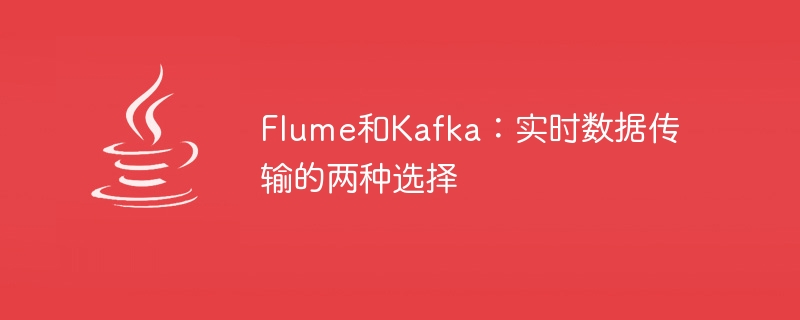Home >Java >javaTutorial >Real-time data transmission: two solutions to choose between Flume and Kafka
Real-time data transmission: two solutions to choose between Flume and Kafka
- WBOYOriginal
- 2024-01-31 15:05:21881browse

Flume and Kafka: Two options for real-time data transmission
Overview
Flume and Kafka are both open source platforms for real-time data transmission. They all feature high throughput, low latency, and reliability. However, there are some differences in their design and implementation.
Flume
Flume is a distributed, reliable and scalable log collection, aggregation and transmission system. It supports multiple data sources, including files, Syslog, Taildir, Exec and HTTP. Flume also supports multiple data formats, including text, JSON, and Avro.
Flume’s architecture is shown in the figure below:
[Picture]
Flume’s components include:
- Source: The source component is responsible for collecting data from the data source.
- Channel: The channel component is responsible for storing and transmitting data.
- Sink: The sink component is responsible for sending data to the target system.
Flume’s configuration file is as follows:
# Name the agent a1.sources = r1 # Describe the source r1.type = exec r1.command = tail -F /var/log/messages # Describe the sink s1.type = hdfs s1.hdfs.path = hdfs://namenode:8020/flume/logs # Use a channel which buffers events in memory c1.type = memory c1.capacity = 1000 c1.transactionCapacity = 100 # Bind the source and sink to the channel a1.channels = c1 c1.sinks = s1
Kafka
Kafka is a distributed, scalable and fault-tolerant messaging system. It supports multiple message formats including text, JSON and Avro. Kafka also supports multiple client languages, including Java, Python, C and Go.
The architecture of Kafka is shown in the figure below:
[Picture]
The components of Kafka include:
- Producer: The producer component is responsible for sending data to the Kafka cluster.
- Broker: The broker component is responsible for storing and forwarding data.
- Consumer: The consumer component is responsible for reading data from the Kafka cluster.
Kafka’s configuration file is as follows:
# Create a topic named "my-topic" with 3 partitions and a replication factor of 2 kafka-topics --create --topic my-topic --partitions 3 --replication-factor 2 # Start a Kafka producer kafka-console-producer --topic my-topic # Start a Kafka consumer kafka-console-consumer --topic my-topic --from-beginning
Comparison
Both Flume and Kafka are excellent platforms for real-time data transmission. They all feature high throughput, low latency, and reliability. However, there are some differences in their design and implementation.
Flume is a distributed, reliable and scalable log collection, aggregation and transmission system. It supports multiple data sources and data formats. Flume's configuration files are simple to understand and easy to use.
Kafka is a distributed, scalable and fault-tolerant messaging system. It supports multiple message formats and client languages. Kafka's configuration file is relatively complex and requires a certain learning cost.
Conclusion
Flume and Kafka are both excellent platforms for real-time data transmission. They all feature high throughput, low latency, and reliability. However, there are some differences in their design and implementation.
Flume is more suitable for log collection, aggregation and transmission. Kafka is better suited for messaging.
Code Example
The following is a code example that uses Flume to collect and transmit logs:
# Create a Flume agent
agent = AgentBuilder.newInstance().build()
# Create a source
source = ExecSourceBuilder.newInstance().setCommand("tail -F /var/log/messages").build()
# Create a channel
channel = MemoryChannelBuilder.newInstance().setCapacity(1000).setTransactionCapacity(100).build()
# Create a sink
sink = HDFSSinkBuilder.newInstance().setBasePath("hdfs://namenode:8020/flume/logs").build()
# Add the source, channel, and sink to the agent
agent.addSource("r1", source)
agent.addChannel("c1", channel)
agent.addSink("s1", sink)
# Start the agent
agent.start()The following is a code example that uses Kafka to send and receive messages:
# Create a Kafka producer
producer = KafkaProducerBuilder.newInstance()
.setBootstrapServers("localhost:9092")
.setValueSerializer(StringSerializer.class)
.build()
# Create a Kafka consumer
consumer = KafkaConsumerBuilder.newInstance()
.setBootstrapServers("localhost:9092")
.setValueDeserializer(StringDeserializer.class)
.setGroupId("my-group")
.build()
# Subscribe the consumer to the topic
consumer.subscribe(Arrays.asList("my-topic"))
# Send a message to the topic
producer.send(new ProducerRecord<>("my-topic", "Hello, world!"));
# Receive messages from the topic
while (true) {
ConsumerRecords<String, String> records = consumer.poll(100);
for (ConsumerRecord<String, String> record : records) {
System.out.println(record.value());
}
}The above is the detailed content of Real-time data transmission: two solutions to choose between Flume and Kafka. For more information, please follow other related articles on the PHP Chinese website!

